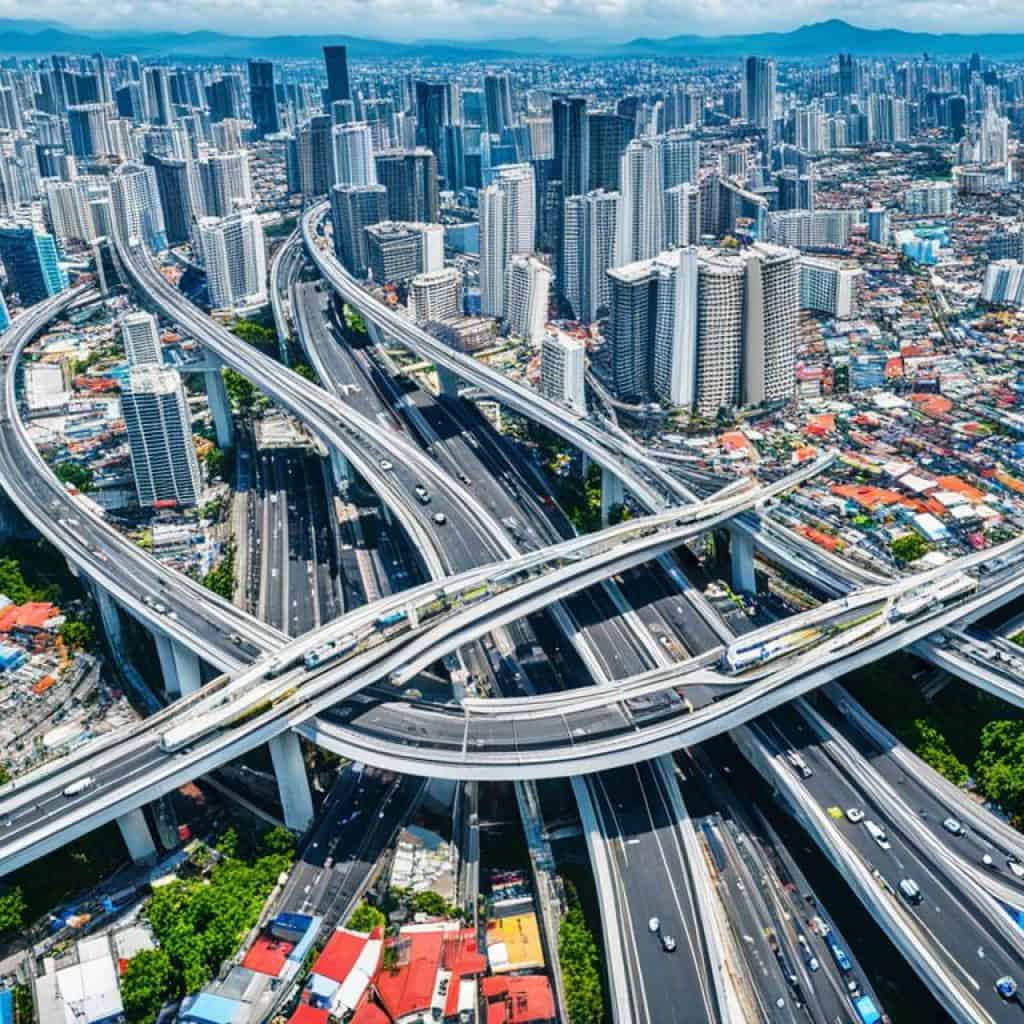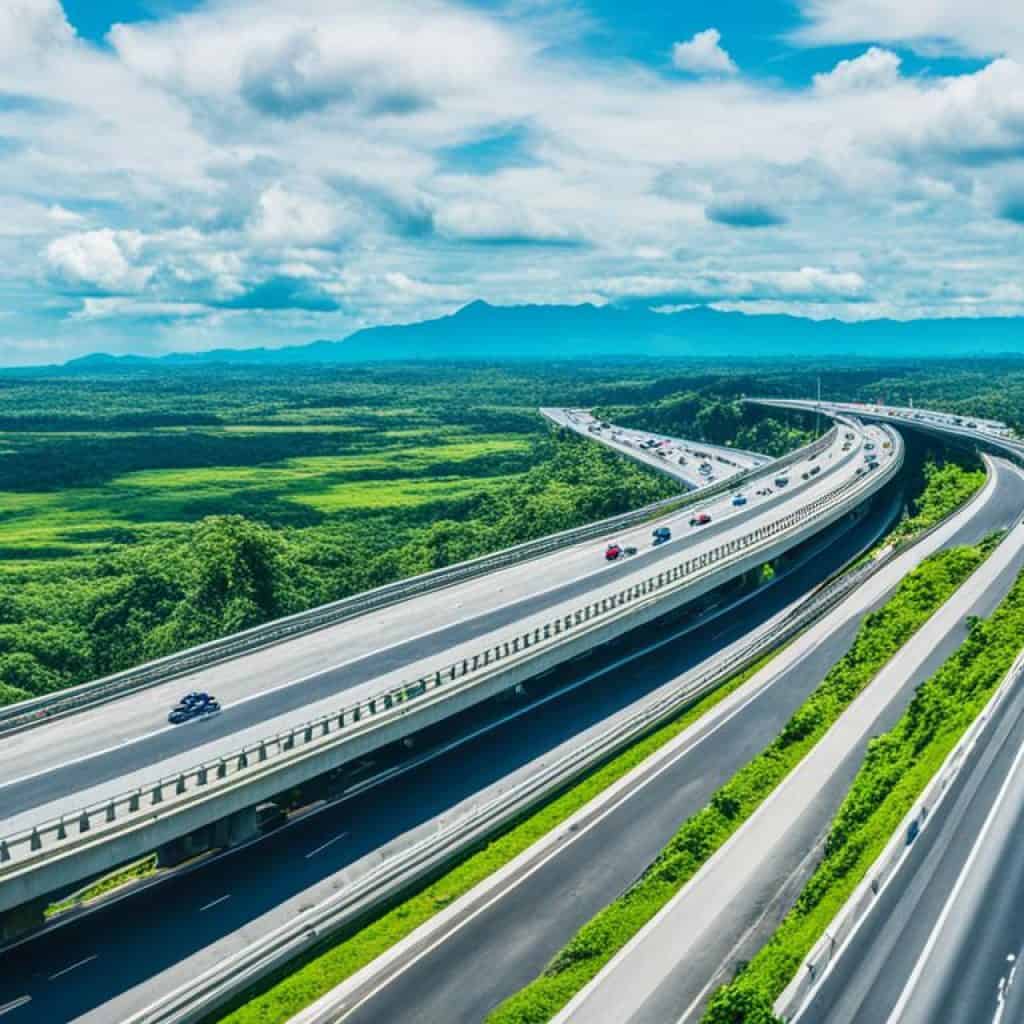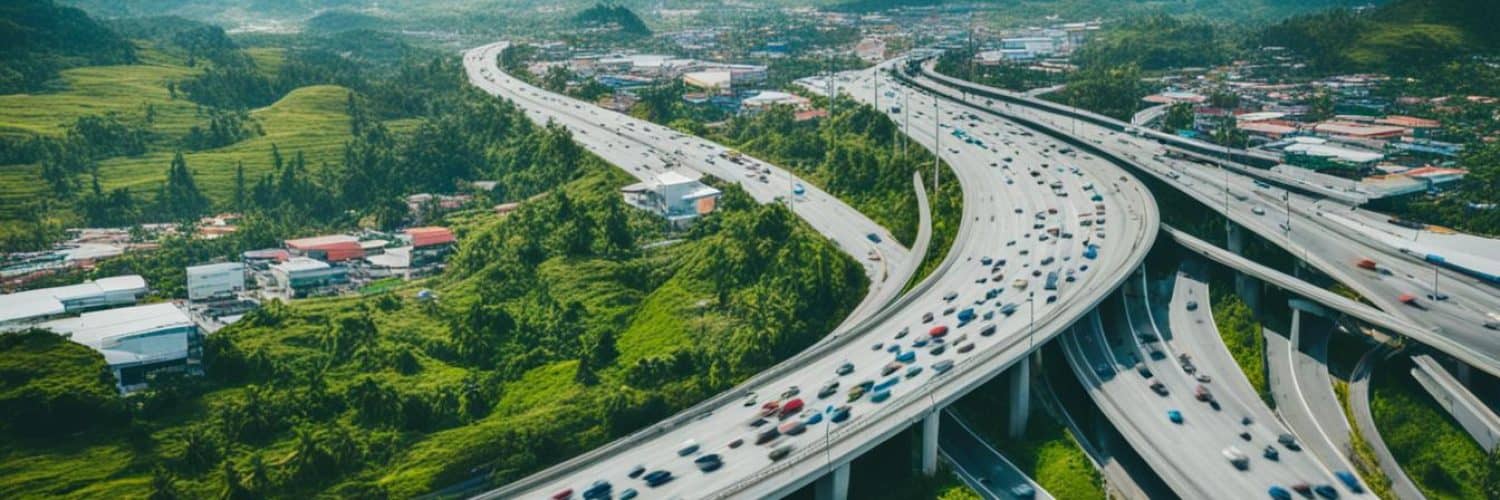Did you know that the Philippines has a comprehensive network of expressways that make travel throughout Luzon and beyond efficient and seamless? From NLEX to SLEX, TPLEX to CAVITEX, and SCTEX to Skyway, these expressways connect major cities and provinces, providing convenient access to various destinations. But have you ever wondered which expressway is the busiest or the longest in the country?
Today, we embark on a journey to explore the expansive network of expressways in the Philippines. Discover the key features of each expressway, the destinations they connect, and the benefits they bring to commuters and travelers alike. Uncover the secrets behind these vital roadways and gain insights into the driving experience on these well-known routes.
Key Takeaways
- The Philippines has a comprehensive network of expressways connecting major cities and provinces
- Some of the key expressways include NLEX, SLEX, TPLEX, CAVITEX, SCTEX, and Skyway
- These expressways provide convenient access to various destinations and help ease traffic congestion
- Understanding the features and benefits of each expressway can enhance your travel experience
- Stay tuned as we delve deeper into the world of expressways in the Philippines
North Luzon Expressway (NLEX)
The North Luzon Expressway, or NLEX, is a toll expressway connecting Metro Manila to the provinces of Central Luzon. Spanning from Balintawak, Quezon City to Santa Ines, Macabalat, Pampanga, NLEX accommodates more than 200,000 motorists per day. As a world-class highway, NLEX plays a vital role in facilitating seamless travel and commerce between Metro Manila and Central Luzon.
The NLEX Corporation, a subsidiary of Metro Pacific Investments Corporation, oversees the continuous renovations and improvement of NLEX, further enhancing its efficiency and safety for commuters and long-haul travelers. With its well-maintained infrastructure and dedication to quality service, NLEX remains a critical transportation artery in the Philippines.
South Luzon Expressway (SLEX)
The South Luzon Expressway, or SLEX, is a major expressway in the Philippines that serves as a crucial transportation link between Metro Manila and the southern part of the region. With its well-maintained infrastructure and strategic location, SLEX offers a convenient and efficient route for travelers heading to cities such as Alabang, Parañaque, and Tagaytay.
SLEX acts as a vital gateway for people traveling from Batangas, Visayas, and Mindanao to Metro Manila, providing them with seamless access to the bustling capital city and its surrounding areas. This expressway significantly reduces travel time and offers a smoother journey, making it a preferred choice for both commuters and long-distance drivers.
Traveling along SLEX allows motorists to enjoy the scenic beauty of South Luzon while experiencing enhanced road safety and convenience. The expressway features well-designed and well-maintained lanes, efficient toll systems, and ample rest areas for drivers to take a break during their journey. Whether you’re a tourist exploring the wonders of Tagaytay or a commuter heading to work in Metro Manila, SLEX offers a reliable and comfortable travel experience.
“SLEX provides easier access to cities such as Alabang, Parañaque, and Tagaytay.”
With SLEX connecting major cities and provinces, it plays a vital role in promoting regional growth and economic development. The expressway facilitates the seamless movement of goods and services, making it easier for businesses to transport their products and expand their reach across different regions of the country.
South Luzon Expressway Features:
- Well-maintained and efficient infrastructure
- Strategic location connecting Metro Manila to the southern region
- Enhanced road safety measures
- Vibrant and scenic views of South Luzon
- Convenient toll systems
- Ample rest areas for drivers
Traveling along the South Luzon Expressway is not only a means of transportation but also an opportunity to explore the diverse attractions and destinations that Luzon has to offer. Whether you’re embarking on a leisurely trip or a business journey, SLEX ensures a smooth and enjoyable travel experience.
So, next time you plan a trip to Metro Manila or the beautiful cities of Southern Luzon, consider taking the South Luzon Expressway for a hassle-free and efficient journey.
Metro Manila Skyway System (Skyway)
The Metro Manila Skyway System, widely known as Skyway, is an essential expressway for motorists traveling from the south. It offers a faster alternative route to avoid heavy traffic on South Luzon Expressway (SLEX). Skyway spans from Buendia, Makati to Alabang, Muntinlupa and is known for its higher toll fare, which contributes to fewer vehicles on the road compared to other expressways.

| Advantages of Metro Manila Skyway System (Skyway) | Disadvantages of Metro Manila Skyway System (Skyway) |
|---|---|
|
|
NAIA Expressway (NAIAX)
The NAIA Expressway, or NAIAX, is an elevated expressway system that provides swift and convenient access to Ninoy Aquino International Airport (NAIA) and its surrounding areas. Connecting Metro Manila Skyway in Pasay City to Newport City in Pasay City, NAIAX offers a seamless journey for travelers heading to or from the airport.
Spanning across Pasay, Taguig, and Paranaque, NAIAX features eight strategically located exits that allow for easy entry and exit points, ensuring a hassle-free travel experience. The expressway’s elevated design helps alleviate traffic congestion and reduces travel time, especially during peak hours, making it an ideal choice for time-sensitive travelers.
Muntinlupa-Cavite Expressway (MCX)
The Muntinlupa-Cavite Expressway, also known as MCX or Daang Hari-SLEX Link Road, is a vital transportation artery in the southern part of Luzon Island, Philippines. This 4-kilometer expressway connects the province of Cavite to Muntinlupa City, providing an efficient and convenient route for motorists.
Operated by MCX Tollway Inc., a subsidiary of Ayala Corporation, MCX offers a seamless travel experience, reducing travel time by an average of 45 minutes, particularly between Daang Hari and the Alabang Interchange. It is a popular choice for commuters and travelers looking to avoid heavy traffic and bypass congested areas.
The MCX is designed to accommodate a substantial volume of vehicles, ensuring smooth traffic flow and superior travel experience. Motorists can enjoy the convenience of this expressway, which features well-maintained lanes, modern toll plazas, and advanced traffic management systems.
Key Features of Muntinlupa-Cavite Expressway (MCX)
- Short 4-kilometer expressway connecting Cavite and Muntinlupa
- Operated by MCX Tollway Inc., a subsidiary of Ayala Corporation
- Reduces travel time by an average of 45 minutes
- Efficient and convenient route for motorists
- Well-maintained lanes, toll plazas, and traffic management systems
MCX contributes to enhanced connectivity and accessibility in the southern part of Luzon. It provides a crucial link between these two areas, promoting economic growth, tourism, and ease of transportation for the local communities.
Tarlac-Pangasinan-La Union Expressway (TPLEX)
The Tarlac-Pangasinan-La Union Expressway, or TPLEX, is an 89.21-kilometer 4-lane expressway that connects Tarlac City in Tarlac to Rosario in La Union. It is part of Expressway 1 (E1) of the DPWH numbering system and was built to reduce travel time for destinations in the North Luzon region, which are popular during holidays and vacations.
TPLEX is a vital transportation route that provides a smooth and convenient journey for both local residents and tourists. With its well-maintained infrastructure, this expressway ensures efficient travel and enhances connectivity between Tarlac, Pangasinan, and La Union.
Experience the benefits of traveling on TPLEX:
- Save time: TPLEX effectively reduces travel time, allowing you to reach your destination faster and maximize your travel experience in the North Luzon region.
- Comfortable travel: The well-paved and well-lit roads of TPLEX offer a comfortable and safe driving experience. Its modern facilities, including service areas and restrooms, provide convenience along the way.
- Scenic drive: As you traverse TPLEX, enjoy the picturesque landscapes and breathtaking views of the Philippine countryside. Capture stunning moments and create unforgettable memories.
- Easier access: TPLEX serves as a gateway to the vibrant cities of Tarlac, Pangasinan, and La Union, where you can explore historical landmarks, beautiful beaches, and delicious local cuisine.
TPLEX brings you closer to the wonders of North Luzon. Whether you’re a nature lover, a history enthusiast, or a beach bum, TPLEX opens up a world of exciting destinations waiting to be explored.
Plan your journey and embark on an unforgettable adventure along the Tarlac-Pangasinan-La Union Expressway. Take advantage of the convenience, efficiency, and beauty that TPLEX offers.

| TPLEX Toll Plaza | Toll Fee (Class 1) |
|---|---|
| Tarlac City (TPLEX) | ₱245.00 |
| Victoria (TPLEX) | ₱125.00 |
| Pozorrubio (TPLEX) | ₱311.00 |
| Urdaneta (TPLEX) | ₱207.00 |
| Rosario (TPLEX) | ₱49.00 |
Subic-Clark-Tarlac Expressway (SCTEX)
The Subic-Clark-Tarlac Expressway, also known as SCTEX, is the longest tollway in the Philippines, spanning 93.8 kilometers. This major expressway connects the cities of Subic, Clark, and Tarlac, providing convenient access to various destinations in the region.
As the longest tollway in the country, SCTEX offers a seamless travel experience for motorists. Maintained by the NLEX Corporation, this well-maintained expressway ensures smooth and efficient journeys, reducing travel time and enhancing connectivity in the area.
With SCTEX, travelers can easily reach key cities and attractions, such as Subic Bay Freeport Zone, Clark Freeport and Special Economic Zone, and Tarlac City. Whether it’s for business or leisure, the Subic-Clark-Tarlac Expressway provides a reliable and convenient transportation option.
The Subic-Clark-Tarlac Expressway (SCTEX) is a testament to the Philippines’ commitment to developing a modern and efficient infrastructure network. With its impressive length and strategic connectivity, this expressway plays a vital role in facilitating economic growth, improving accessibility, and enhancing travel experiences for both locals and tourists.
Key Features of the Subic-Clark-Tarlac Expressway (SCTEX)
| Feature | Details |
|---|---|
| Length | 93.8 kilometers |
| Connects | Subic, Clark, and Tarlac |
| Maintained by | NLEX Corporation |
| Main Attractions | Subic Bay Freeport Zone, Clark Freeport and Special Economic Zone, Tarlac City |
| Benefits | Enhanced connectivity, reduced travel time, improved accessibility |
The Subic-Clark-Tarlac Expressway (SCTEX) continues to contribute to the development and growth of the region by providing a modern and efficient transportation infrastructure. Its seamless connectivity and well-engineered design make it an essential pathway for commuters, businesses, and tourists alike.
Southern Tagalog Arterial Road (STAR Tollway)
The Southern Tagalog Arterial Road, also known as STAR Tollway, is a vital expressway that spans 41.9 kilometers, serving as a crucial link within the transportation system of Batangas. It connects the municipalities of Sto. Tomas and Batangas City, providing convenient travel options for both residents and businesses in the area. Maintained by STAR Infrastructure Development Corporation, STAR Tollway plays a significant role in facilitating smooth and efficient journeys through the province.
With its well-maintained road quality and strategic location, STAR Tollway offers a reliable and seamless route for motorists, reducing travel time and enhancing accessibility within Batangas. Whether for daily commutes or occasional trips, this expressway ensures a hassle-free travel experience, enabling people to reach their destinations safely and efficiently.
A key advantage of STAR Tollway is its contribution to the economic growth of Batangas. By connecting major areas and providing a reliable transportation infrastructure, the expressway facilitates business transactions and trade activities, supporting the development of commerce and industries in the province.
The Southern Tagalog Arterial Road, or STAR Tollway, is an essential component of the Philippine expressway network, offering convenient connectivity and efficient travel options for motorists in Batangas. Experience the benefits of this well-maintained expressway and enjoy a smooth journey to your destination.
| Benefits of STAR Tollway | Details |
|---|---|
| Improved Travel Efficiency | Connects Sto. Tomas to Batangas City, reducing travel time and enabling faster journeys. |
| Enhanced Accessibility | Provides convenient access for residents and businesses in Batangas, promoting economic growth. |
| Smooth Transportation Experience | Offers a well-maintained road quality for a pleasant and stress-free travel experience. |
| Supports Economic Development | Facilitates business transactions and trade activities, driving commerce and industries in Batangas. |
Explore the Southern Tagalog Arterial Road (STAR Tollway) and experience the seamless and efficient travel it provides for motorists in Batangas.
Continuing along our journey of exploring the major expressways in the Philippines, the next section focuses on the Manila-Cavite Expressway (CAVITEx). This expressway serves as a vital link between Metro Manila and the provinces of Cavite, Laguna, and Batangas, offering an efficient transportation route for commuters and travelers.
Manila-Cavite Expressway (CAVITEx)
The Manila-Cavite Expressway, also referred to as CAVITEx or Coastal Road, is a vital transportation route that enhances trade and connectivity between Metro Manila and the provinces of Cavite, Laguna, and Batangas. Spanning a distance of 14.0 kilometers, CAVITEx was constructed in 1998 to efficiently cater to the transportation needs of commuters traveling from Cavite to various workplaces and schools in Manila.
Benefits and Features of CAVITEx
CAVITEx offers numerous advantages for motorists and commuters. The expressway not only reduces travel time but also alleviates traffic congestion on alternative routes, providing a smoother and more efficient journey for those traveling between Manila and Cavite.
“CAVITEx serves as a key link connecting the bustling metropolis of Manila to the thriving provinces of Cavite, Laguna, and Batangas. Its strategic location and well-designed infrastructure make it an essential expressway for locals and tourists alike.”
Additionally, CAVITEx boasts the following notable features:
- Multiple access points in Cavite, allowing for convenient entry and exit from various locations in the province
- Well-maintained road conditions that ensure a safe and comfortable travel experience
- Effective traffic management systems, including toll booths and well-planned entry and exit ramps
Utilizing CAVITEx not only offers a seamless commute but also provides an opportunity to enjoy the picturesque views of the coastal areas along the expressway.
The Economic Impact of CAVITEx
CAVITEx plays a crucial role in bolstering the local economy by facilitating the movement of goods and services between Metro Manila and the provinces it serves. The expressway acts as a gateway for businesses in Cavite, Laguna, and Batangas, enabling them to access the vibrant market in the capital region more efficiently.
The accessibility provided by CAVITEx also boosts tourism and promotes regional development. Travelers who visit the scenic destinations of Cavite, Laguna, and Batangas can easily reach their desired locations via the expressway, contributing to the growth of local businesses and supporting the tourism sector in the region.
CAVITEx Traffic Data
| Year | Number of Vehicles (Average Daily Traffic) |
|---|---|
| 2016 | 68,200 |
| 2017 | 76,800 |
| 2018 | 86,600 |
Table: Average daily traffic on CAVITEx from 2016 to 2018
The table above depicts the consistent growth in the number of vehicles utilizing CAVITEx over the years, highlighting the increasing demand for this vital expressway in the Philippines.

Source: Traffic data obtained from the CAVITEx Traffic Management System
Subic-Tipo Expressway (STipEx)
The Subic-Tipo Expressway, also known as NLEX Segment 7 or Subic Freeport Expressway (SFEX), is an 8.8-kilometer 2-lane expressway that connects the provinces of Zambales and Bataan. This scenic expressway offers a smooth and picturesque journey with its well-maintained roads and beautiful surroundings.
As one of the main arteries leading to the Subic Freeport Zone, the Subic-Tipo Expressway provides easy access to this economic hub, which hosts various industries and businesses. Whether you are heading to Subic Bay for a leisurely vacation or visiting the freeport zone for business purposes, STipEx ensures a convenient and efficient travel experience.
Highlights of Subic-Tipo Expressway:
- Breathtaking views of Zambales and Bataan landscapes
- Smooth and well-maintained roads for a comfortable ride
- Convenient access to the Subic Freeport Zone
- Reduced travel time between Zambales and Bataan
- Easier access to popular tourist destinations in the area
Experience a relaxing and convenient journey along the Subic-Tipo Expressway. Whether you’re a traveler or a daily commuter, this expressway offers a seamless connection between Zambales and Bataan, providing you with stunning views and hassle-free travel.
Since its opening in 1996, the Subic-Tipo Expressway has been serving motorists with its efficient road network. Maintained by the Tollways Management Corporation, STipEx continues to contribute to the development and growth of the region by providing a vital transportation link between these two provinces.
Speed Limits on Expressways in the Philippines
The speed limits on most expressways in the Philippines are as follows:
- For cars: 100 km/h
- For buses and trucks: 80 km/h
- Minimum speed for all vehicles: 60 km/h
However, the NAIA Expressway (NAIAX) has a maximum and minimum speed limit of 60 km/h for all vehicle types.
On highways in the Philippines such as EDSA and Commonwealth Avenue, the speed limit is 60 km/h for all vehicles, while trucks and buses are limited to 50 km/h.
It is crucial to adhere to these speed limits to ensure safe and efficient travel on expressways and highways in the Philippines.
Tips for Safe Driving on Expressways in the Philippines
When driving on expressways in the Philippines, it is important to prioritize safety and follow the speed limit to ensure a smooth and secure journey. Here are some essential tips to keep in mind:
- Adhere to the speed limit: Always drive within the posted speed limit to maintain control over your vehicle and reduce the risk of accidents. This not only ensures your safety but also the safety of other drivers on the road.
- Overtake on the left side: When passing slower vehicles, make sure to overtake on the left side to minimize the chances of collisions. This helps maintain the flow of traffic and prevents abrupt lane changes that can lead to accidents.
- Avoid unnecessary lane switches: Stick to your lane unless it is absolutely necessary to change lanes. Unnecessary lane switches increase the likelihood of confusion and can disrupt the flow of traffic, potentially causing accidents.
- Use your car’s turn signal: Always use your car’s turn signal to indicate your intention to change lanes or make a turn. This alerts other drivers to your actions and helps create a safer driving environment for everyone.
By following these tips and being disciplined, you can ensure a safe and enjoyable driving experience on the expressways in the Philippines.
Conclusion
Exploring the expressways in the Philippines provides a seamless travel experience throughout Luzon and beyond. With a well-connected network of expressways like NLEX, SLEX, TPLEX, CAVITEX, SCTEX, Skyway, and others, it’s easier than ever to navigate major cities and provinces, making transportation convenient and accessible for both local residents and tourists.
By adhering to the specified speed limits and practicing safe driving habits, travelers can ensure a smooth and enjoyable journey on the expressways. It’s important to follow the prescribed speed limits, overtake on the left side to reduce the risk of accidents, avoid unnecessary lane switches, and signal when changing lanes to maintain a disciplined driving experience.
Whether you’re commuting to work, embarking on a road trip, or exploring the beautiful landscapes and destinations of the Philippines, the expressway system offers a reliable and efficient means of transportation. So, buckle up, follow the rules of the road, and enjoy the convenience and comfort of traveling on the expressways in the Philippines.


















Add comment